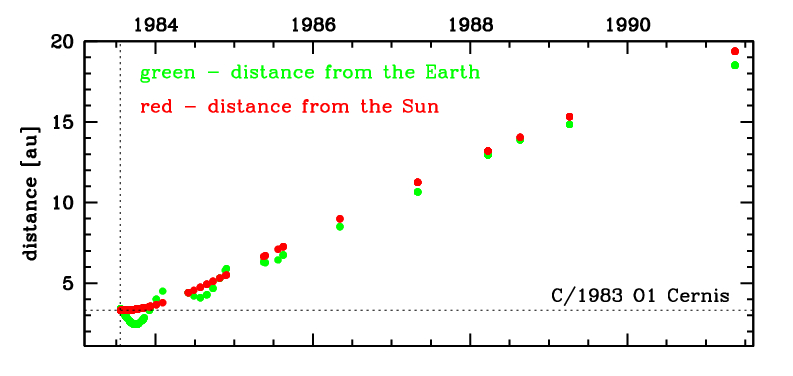C/1983 O1 Cernis
more info
Comet C/1983 O1 was discovered by Kazimeras Černis (Vilnius Observatory) on 19 July 1983 (IAUC 3840), two days before its perihelion passage. The comet was last seen on 14 May 1991.
This comet made its closest approach to the Earth on 29 September 1983 (2.445 au), that was about two months after its perihelion passage.
Solutions given here are based on data spanning over 7.81 yr in a range of heliocentric distances from 3.32 au to 19.38 au.
This Oort spike comet suffers rather small planetary perturbations during its passage through the planetary system that lead to escape the comet from the planetary zone on a hyperbolic orbit (see future barycentric orbit).
See also Królikowska 2014 and Królikowska and Dybczyński 2017.
This comet made its closest approach to the Earth on 29 September 1983 (2.445 au), that was about two months after its perihelion passage.
Solutions given here are based on data spanning over 7.81 yr in a range of heliocentric distances from 3.32 au to 19.38 au.
This Oort spike comet suffers rather small planetary perturbations during its passage through the planetary system that lead to escape the comet from the planetary zone on a hyperbolic orbit (see future barycentric orbit).
See also Królikowska 2014 and Królikowska and Dybczyński 2017.
| solution description | ||
|---|---|---|
| number of observations | 232 | |
| data interval | 1983 07 21 – 1991 05 14 | |
| data type | observed only after perihelion (POST) | |
| data arc selection | entire data set (STD) | |
| range of heliocentric distances | 3.32 au – 3.32 au (perihelion) – 19.4 au | |
| type of model of motion | NS - non-gravitational orbits for standard g(r) | |
| data weighting | YES | |
| number of residuals | 461 | |
| RMS [arcseconds] | 1.11 | |
| orbit quality class | 1a | |
| next orbit statistics, both Galactic and stellar perturbations were taken into account | ||
|---|---|---|
| no. of returning VCs in the swarm | 0 | |
| no. of escaping VCs in the swarm | 5001 | |
| no. of hyperbolas among escaping VCs in the swarm | 5001 | * |
| next reciprocal semi-major axis [10-6 au-1] | -188.29 – -185.64 – -182.95 | |
| next perihelion distance [au] | 0.17 – 0.179 – 0.189 | |
| synchronous stop epoch [Myr] | 1.21 | S |
| percentage of VCs with qnext < 10 | 100 | |
| next_g orbit statistics, here only the Galactic tide has been included | ||
|---|---|---|
| no. of returning VCs in the swarm | 0 | |
| no. of escaping VCs in the swarm | 5001 | |
| no. of hyperbolas among escaping VCs in the swarm | 5001 | * |
| next reciprocal semi-major axis [10-6 au-1] | -188.24 – -185.58 – -182.89 | |
| next perihelion distance [au] | 0.223 – 0.244 – 0.265 | |
| synchronous stop epoch [Myr] | 1.25 | S |
| percentage of VCs with qnext < 10 | 100 | |
